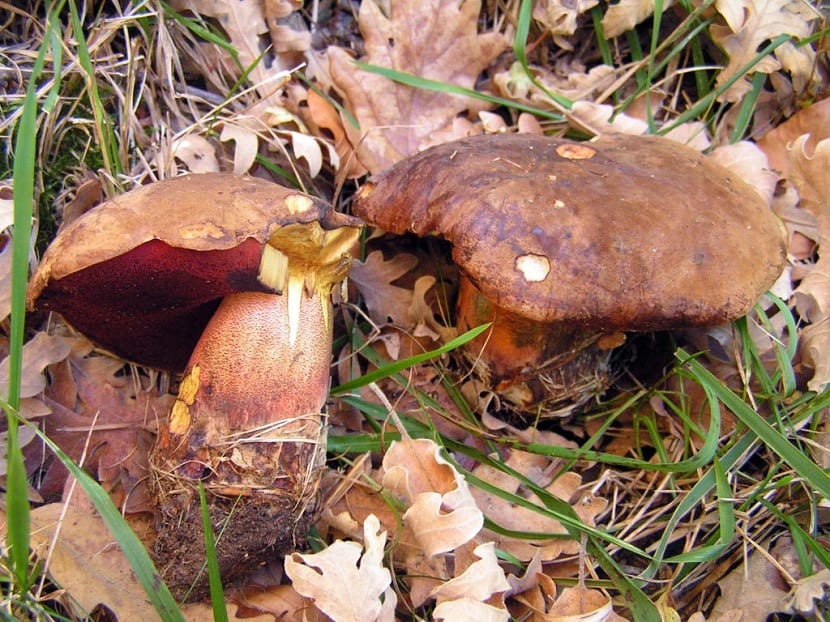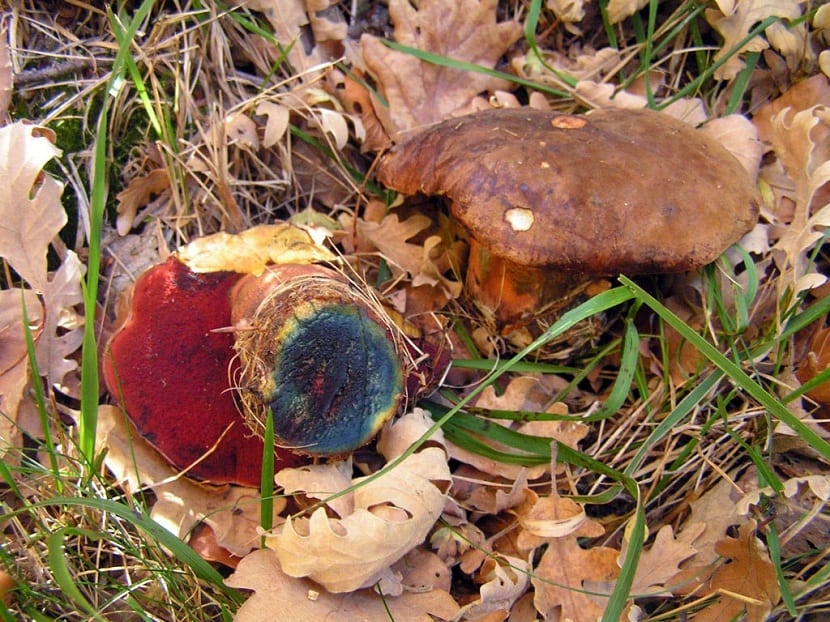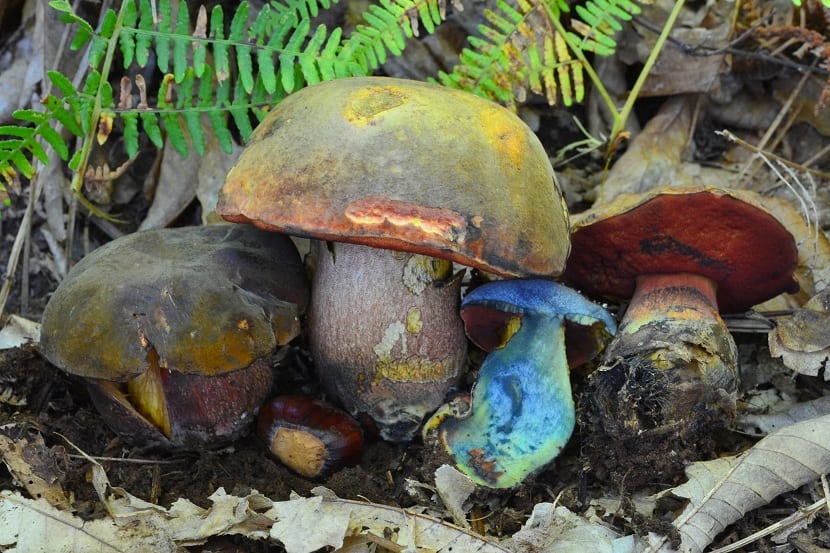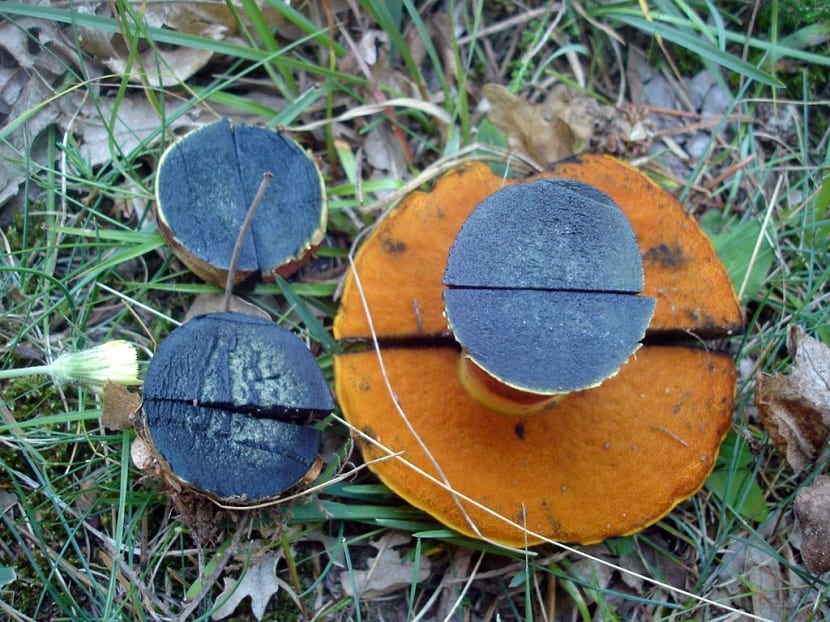
A mushroom commonly known as red foot is one of the most popular mushrooms for being a good option in gastronomy. It is the mushroom whose scientific name is Boletus erythropus. Its name is due to its striking colors. However, when you cut it, it turns a deep blue color that makes many of the people who see it end up despising it.
In this article we are going to tell you about the main features of the Boletus erythropus as well as its properties and its gastronomic benefits.
Key features

It is a type of mushroom whose hat measures between 5 and 15 centimeters in diameter. Sometimes we find some specimens that are capable of measuring something else but it is not normal. Its shape is hemispherical in principle and I do it becomes convex being at the end a convex plane. It can have some shades of reddish color sporadically and it is usually dark brown or chestnut in color. Their cuticles have a velvety texture when they are more immature and, as they develop, they acquire a drier and more stormy texture. The margin is usually excellent.
As for the tubes, they have a yellowish color and turn blue when cut. This is what makes many people look down on this type of mushroom as they mistake it for a poisonous mushroom. These tubes can be separated quite easily from the meat of the hat. They have pores of a garnet color when they are young with a round shape and not too large in size. If some pressure is exerted on them, they also turn blue.
When you take one of these mushrooms and handle them, you can see how they turn this blue color that looks as if it were poisonous. Its foot is quite thick and it gets longer with time. It narrows where it meets the hat and has a yellow background color. It is dotted over its entire surface with a bright red color and lacks a reticule.
As for the meat, It has a striking greenish yellow color and when cut it is stained an intense blue. The fairly thick and consistent. We can see that it is a softer meat in the area of the hat than in the foot. Therefore, it is the most demanded part of this mushroom. Its smell is quite mild and barely perceptible. It has a fairly sweet taste.
Habitat and description of Boletus erythropus

We can find these specimens during the month of May until well into the fall. This makes us see that it is a fungus that needs higher temperatures and the typical summer humidity. It bears fruit profusely if it was under deciduous pines. It needs shade and humidity to be able to stay in good condition.
It is a good edible that is routinely despised for what we have mentioned of turning blue when treated or cut. For this reason, you can find various specimens cut and abandoned on many occasions nearby in areas where mushroom picking is practiced. However, despite its appearance, it has a fairly high yield in the kitchen since it is not attacked by insect larvae.
It is commonly mistaken for the mushroom Suillellus luridus. This specimen has a yellow foot with a vinous red base. It is also often confused with the suillellus satanas which it is a toxic species. To differentiate it we have to see that it has a whiter color and bluffs in a weaker way when it is cut or pressed.
El Boletus erythropus It is one of the best known of this genre. It is a good edible with good texture and taste similar to mushrooms like Boletus gr. edulis. When you cook the meat of this mushroom it turns a creamy and yellowish color. The problem with mushrooms that turn blue when cut is that they have little appreciation among mushrooms. However, it is a species with quite a gastronomic quality.
It turns blue when cut because has a phenolic compound called boletol. This compound does not have a property of the yellow coloration of the meat of the fungus. Boletol reacts with oxygen in the air through an enzyme called laccase. This is how a kind of oxidation is generated with the minimum amount of water (in this case, the present in the humidity itself) and causes it to turn a blue color.
Similarities and differences of Boletus erythropus with other mushrooms

To avoid different confusion when collecting the Boletus erythropus We are going to tell you some tips to avoid making mistakes. There are several mushrooms that also turn blue when cut and pressed and it is important to know how to distinguish them. This is because other specimens can be inedible and even toxic. We are going to give you some differences so that you can recognize them at a glance:
- One of the tickets that is often confused with is the Boletus queletii Schulzer o Suillellus queletii. It has pink flesh and is somewhat more acidic. It is not toxic but you can tell if you see that it has an orangeier cuticle and the base of the foot red and without decoration.
- If you find that the hymenium has very red pores it is a Boletus Luridus o Suillellus luridus. This color of the pores continues on the foot but with the base of a purple color. The meat is yellow in color and also turns blue when cut. However, it is a slightly lighter blue. This species is toxic raw, although it can be consumed if it is well cooked.
- Another mushroom to change being cut blue is the Boletus dupainii. Normally in its usual state, we find it in scarlet red. Their skin is yellow almost completely and like a red color at the base. Although it is edible, it has a not very good quality.
As you can see, you have to look closely before you know what species we are collecting. I hope that with this information you can know more about the Boletus erythropus.